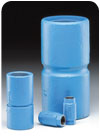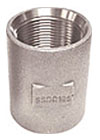
Ductile iron check valves.
I received the following e-mail in response to my article in the July 2006National Drilleron submersible pump accessories, and it brings up an important issue, so I decided to dedicate this article to my response.
Mr. Pelikan's article, “Submersible Pump Accessories” (July, 2006), recommends using no-lead brass, stainless steel or galvanized steel pipe couplings and check valves on galvanized steel drop pipe. Both brass (leaded or lead-free) and stainless couplings and check valves create a dissimilar metal connection that will lead to significant and fast galvanic corrosion, or electrolysis of the galvanized drop pipe. The only material suitable for use as a coupling on galvanized pipe is a galvanized coupling.
Galvanized pipe also loses its zinc coating on the pipe when the threads are cut into the pipe ends. Thus you would have a stainless or brass coupling (or check valve) threaded directly on to bare steel, creating a joint that is highly susceptible to electrochemical corrosion.
I am no expert on pipe or couplings, but I am familiar with galvanic corrosion, as it pertains to pitless units and pitless adapters. Whenever we see a stainless or brass nipple inserted directly in to one of our galvanized pitless units or adapters, the galvanic corrosion destroys the galvanized metal rather quickly.
I should add that I am not a pump installer, and there may be many installers who use dissimilar metals for their pipe connections. I just think that this point would have been worth mentioning in his article.
Keep up the great work!
Sincerely,
John Falconer
Baker Manufacturing Co.

Galvanized drop pipe coupling.
Here are some of the factors that contribute to dielectric corrosion.
- For dielectric corrosion to occur, you need to have a conductive electrolyte. The more conductive the electrolyte, the greater the corrosion. Seawater, for instance, would be much more likely to promote dielectric corrosion than distilled water. Most well water falls closer to the distilled water end of the spectrum, but there are water wells out there with some very conductive water. So, the conductivity of the well water doesn't really explain why our industry seems to be getting away with using stainless and brass couplings with galvanized drop pipe.
- The temperature of the electrolyte also is a factor - the higher the temperature, the more aggressive the corrosion. In the ground water business, we usually are dealing with relatively cool water temperatures.
- The rate and extent of corrosion potential depends on the electrical resistance of the joint between the metals. The better the electrical connection, the higher the potential for corrosion. The use of pipe dope or tape sealants increases the electrical resistance of the joint, thus reducing the potential for corrosion. My guess is that this factor may have some beneficial effect in our case, but it is not the silver bullet.
- The relative areas or masses of the anodic metal (the galvanized steel drop pipe, in our case) with respect to the cathodic metal (the coupling or check valve) greatly affects the amount of galvanic corrosion. A large cathode (coupling) connected to a small anode (drop pipe) would be a disastrous combination, leading to severe degradation of the drop pipe. In our situation, the opposite is the case. We have a relatively small cathode (coupling or check valve) and a very large anode (drop pipe). I think this explains why we are getting away with mixing potentially incompatible materials.
My recommendation to pump installers on this and most other questions regarding which components to use in any particular situation is to follow the lead of the rest of the installers in your area. Not blindly, but if they are using no-lead brass couplings and/or check valves with galvanized steel drop pipe and are not having galvanic corrosion problems, it probably means that the water in the area is not aggressive enough to cause problems. Your dedicated ground water pump distributor is the best source of information as to what products to use in a particular area. He stocks product and sells to the professional installers in his service area and knows what works by what is selling.
Why don't I recommend galvanized couplings to be on the safe side? There are a couple of reasons. The use of galvanized drop pipe is more and more relegated to deep settings where PVC drop pipe won't work, and the feedback I get from installers who have used galvanized couplings is that they've had them break in these deep-set applications. Granted, the ones that failed probably were the imported hardware store variety, but the fact that they failed makes all galvanized couplings suspect. The second reason is the fact that there are only a couple of pump accessory manufacturers that make galvanized drop pipe couplings designed as such, with a proper tapered lead-in to facilitate installation and enough material to hold the weight.
What about the question as to which type of check valve to use with galvanized steel drop pipe? I didn't mention ductile iron check valves in my article because there only are a couple of manufacturers offering them in domestic well drop pipe sizes, and they are not widely used in domestic wells, which are the focus of my articles. If you can find them in your area, they would be a good, safe choice.
The bottom line as to which couplings and check valves to use with galvanized steel drop pipe is this: Ask your pump equipment distributor what the other installers are using in your area and go with that. Otherwise, use galvanized drop pipe couplings (not imported hardware store couplings) and/or ductile iron check valves.
Thanks to Mr. Falconer for bringing up this issue. Next month, we will continue the series on submersible pump accessories with a look at pump cable splicing. 'Til then ….
ND




Report Abusive Comment